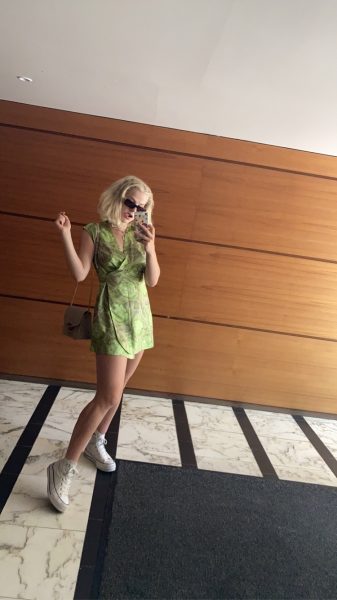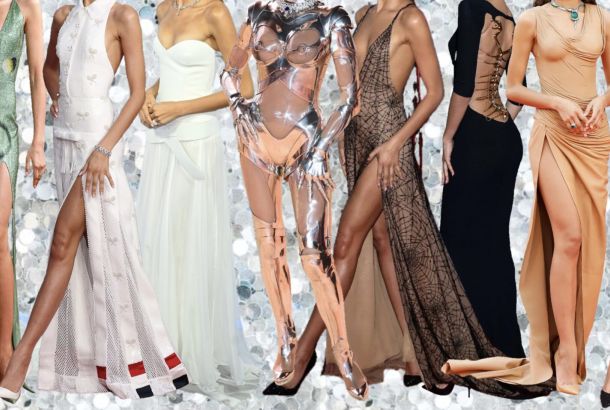Styled, steamed, shimmered: Stories of second-hand September

The shift towards a sustainable future is slow, but gradually gaining traction, and recent months have seen changes in both how and where we can shop.
It seems that the temptation to shop online and develop weekly spending habits with fast fashion is ever-present; we are browsing online and making new purchases at an increasing rate. It is something that comes up time and time again in weekly phone conversations and Zoom calls: “What did you buy?”, “Where did you buy it from?” – and the quest for the ultimate student discount code.
However, our increased understanding of the life cycle of garments, from production to their quick disposal, has encouraged change. We must combat the destructive actions of the past and find ways to reduce our impact on both people and the planet.
For many, taking the Oxfam pledge to shop #secondhandseptember was a natural starting point that raised awareness of alternative, sustainable clothing choices. This month-long experiment attempted to enact a change in mindset towards our fashion consumption, from where we source items to their re-wearability.
View this post on InstagramA post shared by Oxfam GB (@oxfamgb) on
The project began after an Oxfam-commissioned study revealed that over two tonnes of clothing was bought every minute. Of that astronomical figure, the UK sends thirteen million items of clothing to landfill every year.
This shocking statistic alone conveys the stark environmental damage that fast fashion enacts, and indicates its destructive nature beyond economic deterioration. With the assistance of Oxfam, many pledgers began carefully and creatively reorganising their wardrobes, as well as exploring existing items on the market.
After taking the pledge for the first time last year, I was surprised at how many options suddenly came into focus. I started by attending a swap shop with friends – we met up with bags of freshly washed clothing ready to exchange, devising outfit choices together from the comfort of the living room. It was the perfect opportunity to offer up items that were still in excellent condition but in desperate need of a re-style.
I swapped many shimmering crop tops and the odd, ill-advised printed shirt, that were now able to discover a new lease of life. In return, I gained some great items including a stunning pair of white Carhartt dungarees – proving that one person’s junk can be another’s gold.

Although events could not take place in the same way as previous #secondhandseptember projects, this year things moved online, with effective and approachable second-hand success stories being shared of the horrors and heroes shoppers found at online stores.
One such wonder website, Depop, allows users to sell pre-loved items on an easy-to-access platform. This new way of looking at clothes can also give people the confidence to make style choices and take risks based on exciting vintage finds and shared knowledge of styles in our local community.
The site is a firm favourite of Editor-in-Chief, Anja Samy, who commented: “I found so many hidden gems … it felt even easier to shop on peer-to-peer platforms because I could search for things that I really wanted, even if they may not be this season’s trend.”
A cropped flannel shirt was her top find this month, which is a comfortable option that is “great for layering” in the autumnal months ahead.
View this post on InstagramA post shared by Depop (@depop) on
This month also revealed the re-occurrence of vintage styles which spin through cycles, throwing some interesting finds into the most unexpected places. For myself, an inherited, generational love of clothes meant that discussion and re-purposing of 70s, 80s and 90s gems regularly took place throughout the month. As fast as clothes were swapped, more satin shirts and quirky cut jeans were acquired.
This experience was mirrored by Beauty Editor, Alex Bikard, who found delight in rediscovering and re-imagining family treasures. Throughout September, she found comfort in her travels wearing “a green vintage dress” that she had inherited from her grandmother. She noted that she “would rather buy and wear very beautiful investment pieces, ideally pre-loved ones that would last [her] a lifetime”, valuing styling, instead of buying several new pieces.

From the discarded garments of friends and family, to finding hidden gems on the market, a financially viable opportunity is presented by swapping and sharing our clothing. Embracing the vision of shopping second-hand, rather than the vastness of fast fashion, allows us to connect and showcase our social diversities, presenting us with the ability to be imaginative and put collaboration first.
When cultural and environmental impacts are considered, we can reduce the cost of our own monthly spend, and support our most vulnerable communities worldwide, showing that love of the material can easily be slow and sustainable.







